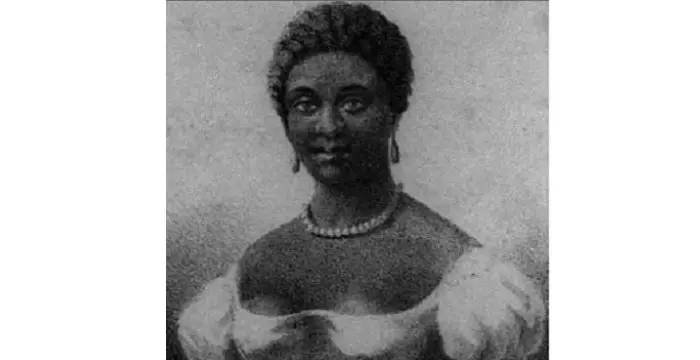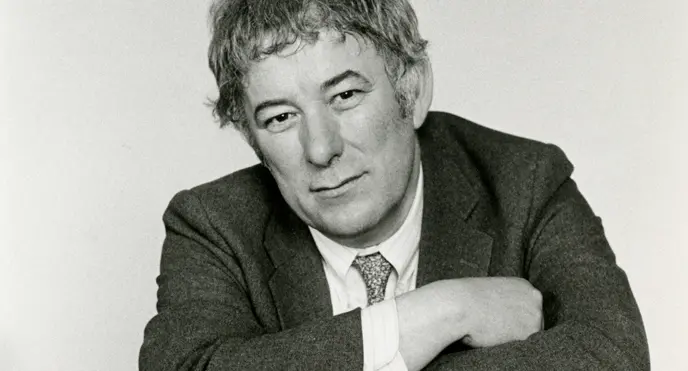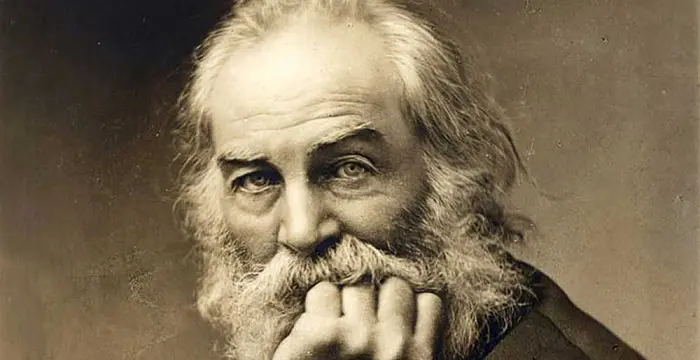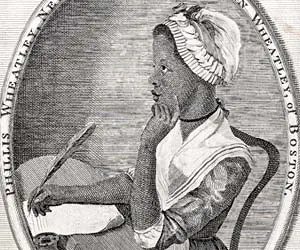
Phillis Wheatley - Poets, Family and Family
Phillis Wheatley's Personal Details
Phillis Wheatley was the first published African-American female poet
| Information | Detail |
|---|---|
| Birthday | May 8, 1753 |
| Died on | December 5, 1784 |
| Nationality | American |
| Famous | Writers, Poets |
| Spouses | John Peters (m. 1778–1784) |
| Birth Place | West Africa |
| Gender | Female |
| Sun Sign | Taurus |
| Born in | West Africa |
| Famous as | Poet |
| Died at Age | 31 |
// Famous Poets
Charles Bukowski
Charles Bukowski was a German-born American novelist, short story writer and poet. With this biography, learn in details about his childhood, life, works, career and timeline
Seamus Heaney
Nobel Laureate Seamus Heaney was an Irish poet, playwright and translator. Know about his profile, childhood, life and timeline in the biography below.
Walt Whitman
Walt Whitman was an American poet, journalist and humanist. Read this brief biography to find more on his life & timeline.
Phillis Wheatley's photo
Who is Phillis Wheatley?
Phillis Wheatley was the first published African-American female poet. She was born in the middle of the eighteenth century, possibly in areas in or around Senegal. Captured around the age of seven, she was sold to a distinguished Bostonian family as a domestic slave. As was the tradition those days, the family renamed her Phillis after the slave ship that brought her, also giving her their surname Wheatley. However, unlike other slaveholders, they gave her education and encouraged her to write poetry. Very soon, she became a part of the household and the family took active interest in publishing her only book, ‘Poems on Various Subjects, Religious and Moral’, setting her free shortly thereafter. Unfit for any hard job, her life after the death of her benefactors was spent in poverty. Working as a charwoman, she continued to write, but could not publish her second collection of poems for want of subscriptions. The poet, who had been invited by George Washington for poetry reading, died alone and uncared for in a boarding house among abject poverty, at the age of thirty-one.
// Famous Writers
Joyce Meyer
Joyce Meyer is a Christian author and speaker. This biography provides detailed information about her childhood, life, achievements, works & timeline
Temple Grandin
Temple Grandin is a well-known American writer, autistic activist and animal expert. This biography profiles her childhood, life, achievements, career and timeline
Tennessee Williams
Tennessee Williams was one of the greatest playwrights of the 20th century. This biography of Tennessee Williams provides detailed information about his childhood, life, achievements, works and timeline.
Childhood & Early Years
Although nothing specific is known about Phillis Wheatley’s early childhood, scholars believe that she was born in and around 1753 in West Africa, possibly in present day Senegal or Gambia. We just know that she was kidnapped and sold to slave traders when she was a child.
The little girl, whose actual name was never known, was brought to the USA aboard the slave ship ‘Phillis’ owned by wealthy Boston merchant Timothy Fitch. It was a difficult trip, spanning 240 days. By the time it docked at Boston harbor on 11 July, 1761, twenty-one slaves had died.
At that time, her front teeth were missing, leading to the belief that she was around seven years old. A very frail girl unsuitable for hard labor, she was sold to John Whitney, a well-known Bostonian tailor looking for a domestic help for his wife Susannah, at a throwaway price.
Scholars believe that there could be two reasons why they chose this frail girl over stronger slaves. Firstly, the little girl was a status symbol, showcasing they had money to spare. But more likely, she reminded them of their departed daughter Sarah, who died exactly at the same age.
On bringing her home, they renamed her Phillis, after the slave ship that brought her to America. Although she was not entirely absolved of her domestic duty she was raised above her station and was given religious instructions. However, she was not baptized until August 1771.
It is not known when, but very soon, she started her education under John Whitney’s daughter Mary and son Nathaniel. After mastering English, Phillis began to study Greek and Latin, shortly surprising everybody by translating Ovid. Slowly, she also started studying ancient history, geography, astronomy and literature.
Sometime around the age of twelve, encouraged by the Wheatleys, Phillis started writing poems. At thirteen, she wrote ‘On Messrs. Hussey and Coffin’, about two men, who nearly drowned in the sea. Published on 21 December 1767 in the Mercury Newport, it became her first published work. .
As her talent became more and more apparent, the family absolved her of her domestic duties, allowing her to concentrate on her studies. She was also allowed to mingle with the distinguished guests who often came visiting the Wheatleys, slowly becoming a part of the family.
One day, as Phillis had gone out, the weather suddenly turned damp. Mrs. Wheatley, fearing for her health, sent the chaise to fetch her back. On seeing the coachman, another slave, sharing his seat with Phillis, she became furious and reprimanded him for forgetting the dignity attached to ‘her Phillis’.
Emerging Poet
While ‘On Messrs. Hussey and Coffin’ was her first published work, scholars believe that her first ever poem, written at the age of twelve, was ‘To the University of Cambridge in New England’. Published much later in 1773, the poem addresses the Harvard University students as ‘sons of science’.
From the poem, we can gather that by then, she had become a devout Christian. She thanked God for bringing her safely to the USA and reminded the students, how Jesus has shed blood for them, asking them to shun evil. Indeed, religion played an important part in her works.
Modeling her poems on famous poets of the day, particularly Alexander Pope, she continued to write, having her first published work in 1765. However, much as she admired Pope, she never tried to write satire, one of his major literary characteristics.
Although many white Bostonians adored her, she was very much aware that she was still a slave, not their equal and so wrote nothing that would offend them. In every day behavior too, she would keep a respectful distance, never sharing a table, even if she was invited.
To the King's Most Excellent Majesty’, written in 1768, is another of her major work of this period. In this poem, she praised King George III of England for repealing the Stamp Act. Later, as the American Revolution gained momentum, she started writing from the perspective of the colonist.
Also in 1768, she wrote, ‘On Being Brought from Africa to America’. It is her only published poem, which alluded to her slavery. In it, she chided the white Americans, saying, “Remember, Christians, Negroes, black as Cain / May be refined, and join th’ angelic train.”
Although her writings were much appreciated in closed circle, she had to wait until 1770 to be nationally recognized. In that very year, she wrote an elegy, ‘On the Death of the Rev. Mr. George Whitefield’, which gained her national attention.
By 1772, she had gathered a collection of twenty-eight poems to be published in book form. In February, with the help of Mrs. Wheatley, she ran advertisements for subscribers in Boston newspapers, but failed to receive any response.
Realizing that white Americans were not yet ready to support the literally aspiration of an African slave, they now turned to Great Britain, sending the ‘Whitefield’ poem to Selina Hastings, Countess of Huntingdon. May be because Whitefield had been chaplain to her, she came forward to have Whitney’s collection published.
Also in 1772, she was forced to defend her poems in court because most white Americans doubted their authenticity. She was examined by Boston luminaries like John Erving, Reverend Charles Chauncey, John Hancock, Thomas Hutchinson and Andrew Oliver, who later attested her works. She also gained support from Benjamin Rush.
In May 1773, she accompanied Nathaniel Wheatley on a business trip to England. There, with the help of Countess of Huntingdon, she had her only collection of poems, ‘Poems on Various Subjects, Religious and Moral’, published on September 1, 1773.
The trip was also socially successful, being welcomed by many famous abolitionists. In spite of that, she returned to Boston in the same month due the illness of her mistress, who died six months later on 3 March 1774. But before that, Phillis was set free on October 18, 1773.
A Free Woman
Although Phillis Wheatley had been a slave almost all her life, she never experienced the drudgery that was part of slave life. Instead, she had led a protected a life in the Wheatley household. But the situation changed soon after she became free.
With the death of her mistress in 1774, of Mr. Wheatley and her daughter, Mary, in 1778, her life became more and more tenuous. It became worse, when against the advice of her close friends she married a free black, John Peters. In spite of that, she continued to write.
In 1775, she sent a copy of a poem, ‘To His Excellency, George Washington’ to him. In the following year, he invited her to visit him at his headquarters in Cambridge, Massachusetts. She met him in March 1776 and in April the poem was republished in the Pennsylvania Gazette.
In 1779, Wheatley tried to publish a second collection of her poems. By then, all her benefactors except Nathaniel were dead. He too had married and moved to England. Wheatley had expected helps from her evangelical friends; but due to war situation and bad economic condition, nothing came of it.
Between 30 October and 18 December 1779, she ran six advertisements soliciting subscribers for a volume “Dedicated to the Right Hon. Benjamin Franklin, Esq.: One of the Ambassadors of the United States at the Court of France”. But this time too, the white Americans refused to respond.
The book would have included thirty-three poems and thirteen letters. But, as she failed to find a publisher, they remained with her. Ultimately, many of the poems were lost. However, some of the remaining poems were published two years after her death in newspapers and pamphlets.
In last years of her life, she had to face acute poverty, having to maintain herself by working as a charwoman. In spite of that, she continued to write. The last poem that she was able to publish was ‘Liberty and Peace’ (1784); in it she congratulated America on her victory over England.
Major Works
Phillis Wheatley is best remembered for her 1768 poem, ‘On Being Brought from Africa to America’. A powerful poem about slavery, it addresses her concern about racial inequality, using Christianity to shed light on the subject.
The poem appeared in her only published book, ‘Poems on Various Subjects, Religious and Moral’, which itself made sensation in England and America. As most whites refused to believe that blacks were capable of writing poetry, she had to publish an attestation, made by distinguished Bostonians, in the preface.
Poems on Various Subjects, Religious and Moral’ was important for another reason also. It was the second book to be published by an African-American and the first book to be published by a black woman. It thus opened door for other African-American writers, inspiring them to create history.
Personal Life & Legacy
On April 1, 1778, Wheatley married John Peters, a handsome and well-mannered free black, whom she had known for five years. He aspired to be great, calling himself Dr. Peters, practicing law and keeping a grocery store at the court. However, his business acumen did not match his dreams.
Soon after their marriage they moved to Wilmington, Massachusetts. Shortly returning to Boston they set up their home in the run-down section of the city. In spite of trying his best, Peter could not find any job and their financial condition became poorer day by day.
To dodge creditors and also to find new jobs Peter left her often enough. During this lean period, Wheatley began working as a charwoman, concurrently continuing to write poetries and trying to publish them.
In 1784, Peter was imprisoned for his debts, leaving Wheatley to work as a scullery maid at a boarding house to feed herself and her surviving infant son. Although there is no record, it is possible that she bore Peter two more children, both of whom died in infancy.
Whitney with her frail health was not accustomed to the hard work. She soon became ill and died on December 5, 1784, alone and uncared for among squalid poverty at the age of thirty-one. Her infant son also died at the same time.
Apart from her own works, ’ Memoir and Poems of Phillis Wheatley’, published posthumously in 1834 and ‘Letters of Phillis Wheatley, the Negro Slave-Poet of Boston’ published in 1864, continue to carry her legacy.
Over the years, her works were often cited by reformists to negate the belief, common among the American whites, that Negroes were intellectually inferior and to promote education among them. She also inspired many African Americans to write.
In 2003, she has been featured in the Boston Women's Memorial, located on Commonwealth Avenue, with a sculpture, later being commemorated on the Boston Women's Heritage Trail.
Wheatley Hall at UMass Boston, Phyllis Wheatley YWCA in Washington, D.C; and the Phyllis Wheatley High School in Houston, Texas has all been named after her.
// Famous Taurus Celebrities peoples
Jason Simpson
Jason Simpson is the son of former NFL running back, broadcaster and actor O. J. Simpson. Check out this biography to know about his childhood, family, life, and little known facts about him.
Sophie Reade
Sophie Victoria Reade is a British model and reality show star. Let’s take a look at her family and personal life, including her age, birthday, boyfriends, and some interesting facts.
ASMR Aspen
ASMR Aspen is an American YouTuber. Check out this biography to know about her birthday, childhood, family life, achievements and fun facts about her.
Phillis Wheatley biography timelines
- // 1753Although nothing specific is known about Phillis Wheatley’s early childhood, scholars believe that she was born in and around 1753 in West Africa, possibly in present day Senegal or Gambia. We just know that she was kidnapped and sold to slave traders when she was a child.
- // 11th Jul 1761The little girl, whose actual name was never known, was brought to the USA aboard the slave ship ‘Phillis’ owned by wealthy Boston merchant Timothy Fitch. It was a difficult trip, spanning 240 days. By the time it docked at Boston harbor on 11 July, 1761, twenty-one slaves had died.
- // 1765Modeling her poems on famous poets of the day, particularly Alexander Pope, she continued to write, having her first published work in 1765. However, much as she admired Pope, she never tried to write satire, one of his major literary characteristics.
- // 21st Dec 1767Sometime around the age of twelve, encouraged by the Wheatleys, Phillis started writing poems. At thirteen, she wrote ‘On Messrs. Hussey and Coffin’, about two men, who nearly drowned in the sea. Published on 21 December 1767 in the Mercury Newport, it became her first published work. .
- // 1768To the King's Most Excellent Majesty’, written in 1768, is another of her major work of this period. In this poem, she praised King George III of England for repealing the Stamp Act. Later, as the American Revolution gained momentum, she started writing from the perspective of the colonist.
- // 1768Also in 1768, she wrote, ‘On Being Brought from Africa to America’. It is her only published poem, which alluded to her slavery. In it, she chided the white Americans, saying, “Remember, Christians, Negroes, black as Cain / May be refined, and join th’ angelic train.”
- // 1768Phillis Wheatley is best remembered for her 1768 poem, ‘On Being Brought from Africa to America’. A powerful poem about slavery, it addresses her concern about racial inequality, using Christianity to shed light on the subject.
- // 1770Although her writings were much appreciated in closed circle, she had to wait until 1770 to be nationally recognized. In that very year, she wrote an elegy, ‘On the Death of the Rev. Mr. George Whitefield’, which gained her national attention.
- // Aug 1771On bringing her home, they renamed her Phillis, after the slave ship that brought her to America. Although she was not entirely absolved of her domestic duty she was raised above her station and was given religious instructions. However, she was not baptized until August 1771.
- // 1772By 1772, she had gathered a collection of twenty-eight poems to be published in book form. In February, with the help of Mrs. Wheatley, she ran advertisements for subscribers in Boston newspapers, but failed to receive any response.
- // 1772Also in 1772, she was forced to defend her poems in court because most white Americans doubted their authenticity. She was examined by Boston luminaries like John Erving, Reverend Charles Chauncey, John Hancock, Thomas Hutchinson and Andrew Oliver, who later attested her works. She also gained support from Benjamin Rush.
- // 1773While ‘On Messrs. Hussey and Coffin’ was her first published work, scholars believe that her first ever poem, written at the age of twelve, was ‘To the University of Cambridge in New England’. Published much later in 1773, the poem addresses the Harvard University students as ‘sons of science’.
- // May 1773 To 1st Sep 1773In May 1773, she accompanied Nathaniel Wheatley on a business trip to England. There, with the help of Countess of Huntingdon, she had her only collection of poems, ‘Poems on Various Subjects, Religious and Moral’, published on September 1, 1773.
- // 18th Oct 1773 To 3rd Mar 1774The trip was also socially successful, being welcomed by many famous abolitionists. In spite of that, she returned to Boston in the same month due the illness of her mistress, who died six months later on 3 March 1774. But before that, Phillis was set free on October 18, 1773.
- // 1774 To 1778With the death of her mistress in 1774, of Mr. Wheatley and her daughter, Mary, in 1778, her life became more and more tenuous. It became worse, when against the advice of her close friends she married a free black, John Peters. In spite of that, she continued to write.
- // 1775 To Mar 1776In 1775, she sent a copy of a poem, ‘To His Excellency, George Washington’ to him. In the following year, he invited her to visit him at his headquarters in Cambridge, Massachusetts. She met him in March 1776 and in April the poem was republished in the Pennsylvania Gazette.
- // 1st Apr 1778On April 1, 1778, Wheatley married John Peters, a handsome and well-mannered free black, whom she had known for five years. He aspired to be great, calling himself Dr. Peters, practicing law and keeping a grocery store at the court. However, his business acumen did not match his dreams.
- // 1779In 1779, Wheatley tried to publish a second collection of her poems. By then, all her benefactors except Nathaniel were dead. He too had married and moved to England. Wheatley had expected helps from her evangelical friends; but due to war situation and bad economic condition, nothing came of it.
- // 18th Dec 1779Between 30 October and 18 December 1779, she ran six advertisements soliciting subscribers for a volume “Dedicated to the Right Hon. Benjamin Franklin, Esq.: One of the Ambassadors of the United States at the Court of France”. But this time too, the white Americans refused to respond.
- // 1784In last years of her life, she had to face acute poverty, having to maintain herself by working as a charwoman. In spite of that, she continued to write. The last poem that she was able to publish was ‘Liberty and Peace’ (1784); in it she congratulated America on her victory over England.
- // 1784In 1784, Peter was imprisoned for his debts, leaving Wheatley to work as a scullery maid at a boarding house to feed herself and her surviving infant son. Although there is no record, it is possible that she bore Peter two more children, both of whom died in infancy.
- // 5th Dec 1784Whitney with her frail health was not accustomed to the hard work. She soon became ill and died on December 5, 1784, alone and uncared for among squalid poverty at the age of thirty-one. Her infant son also died at the same time.
- // 1834 To 1864Apart from her own works, ’ Memoir and Poems of Phillis Wheatley’, published posthumously in 1834 and ‘Letters of Phillis Wheatley, the Negro Slave-Poet of Boston’ published in 1864, continue to carry her legacy.
- // 2003In 2003, she has been featured in the Boston Women's Memorial, located on Commonwealth Avenue, with a sculpture, later being commemorated on the Boston Women's Heritage Trail.
// Famous American peoples
Wentworth Miller
Wentworth Miller is an American actor and screenwriter who achieved recognition for his role in the TV series ‘Prison Break’.
Jason Simpson
Jason Simpson is the son of former NFL running back, broadcaster and actor O. J. Simpson. Check out this biography to know about his childhood, family, life, and little known facts about him.
Melissa Brim
Melissa Brim is the ex-girlfriend of former professional boxer Floyd Mayweather Jr. Check out this biography to know about her birthday, childhood, family life, achievements and fun facts about her.
Skai Jackson
Skai Jackson is an American child actress with huge fan following. Find more about her family & personal life, relationships, facts and more.
Joyce Meyer
Joyce Meyer is a Christian author and speaker. This biography provides detailed information about her childhood, life, achievements, works & timeline
Zoe LaVerne
Zoe LaVerne is an American musical.ly star. Check out this biography to know more about her family, personal life, including her age, birthday, etc.
Phillis Wheatley's FAQ
What is Phillis Wheatley birthday?
Phillis Wheatley was born at 1753-05-08
When was Phillis Wheatley died?
Phillis Wheatley was died at 1784-12-05
Where was Phillis Wheatley died?
Phillis Wheatley was died in Boston, Massachusetts, U.S.
Which age was Phillis Wheatley died?
Phillis Wheatley was died at age 31
Where is Phillis Wheatley's birth place?
Phillis Wheatley was born in West Africa
What is Phillis Wheatley nationalities?
Phillis Wheatley's nationalities is American
Who is Phillis Wheatley spouses?
Phillis Wheatley's spouses is John Peters (m. 1778–1784)
What is Phillis Wheatley's sun sign?
Phillis Wheatley is Taurus
How famous is Phillis Wheatley?
Phillis Wheatley is famouse as Poet













